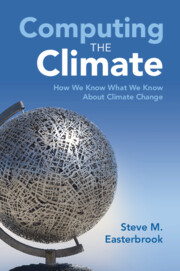Book contents
- Computing the Climate
- Epigraph
- Computing the Climate
- Copyright page
- Contents
- Preface
- Acknowledgements
- 1 Introduction
- 2 The World’s First Climate Model
- 3 The Forecast Factory
- 4 Taming Chaos
- 5 The Heart of the Machine
- 6 The Well-Equipped Physics Lab
- 7 Plug and Play
- 8 Sound Science
- 9 Choosing a Future
- References
- Index
8 - Sound Science
Published online by Cambridge University Press: 10 August 2023
- Computing the Climate
- Epigraph
- Computing the Climate
- Copyright page
- Contents
- Preface
- Acknowledgements
- 1 Introduction
- 2 The World’s First Climate Model
- 3 The Forecast Factory
- 4 Taming Chaos
- 5 The Heart of the Machine
- 6 The Well-Equipped Physics Lab
- 7 Plug and Play
- 8 Sound Science
- 9 Choosing a Future
- References
- Index
Summary
Our confidence in climate science depends to some extent on our confidence that the models are valid. But a computational model can never be perfect, because a model cannot capture everything. What do we mean by “valid”? In this chapter, we will examine how climate modellers test their models, and what they do when they find errors. One surprising result is that climate models appear to be less buggy than almost any other software ever produced. More importantly, climate modellers have adapted the tools of science – hypothesis testing, peer review, and scientific replication – in remarkable new ways to overcome the weaknesses in any individual model, to ensure their scientific conclusions are sound. A study of the Max Planck Institute for Meteorology, in Hamburg, Germany will show how they do this.
- Type
- Chapter
- Information
- Computing the ClimateHow We Know What We Know About Climate Change, pp. 242 - 284Publisher: Cambridge University PressPrint publication year: 2023

